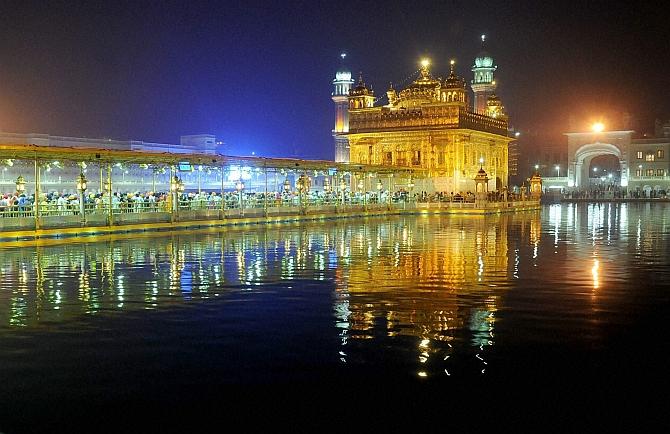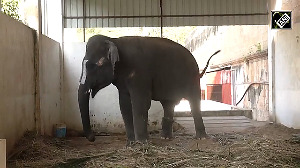The street leading to the Golden Temple gets a makeover that takes you back in time, reports Manavi Kapur.
 For anyone who has visited Harmandir Sahib, or the Golden Temple, in Amritsar, the walk through the bazaar street would have been particularly unremarkable.
For anyone who has visited Harmandir Sahib, or the Golden Temple, in Amritsar, the walk through the bazaar street would have been particularly unremarkable.
A general sense of disorderliness was characteristic of the street from the iconic Bharawan Da Dhaba to the Golden Temple, with pedestrians competing with rickshaw-pullers, hawkers and vendors selling Amritsar specialties.
Having experienced this, the revamped heritage street is as much a shock to the senses as it is a delight.
Beginning at the old Town Hall building, which now houses the Partition Museum, going towards Jallianwala Bagh and then up to the Golden Temple, the one-kilometre stretch feels like a walk through an open monument.
Bright lampposts, buildings with Rajputana and Mughal architectural domes and jharokhas, LED lights illuminating the façades and just the right number of people make it appear almost like the production set of a period film.
This vision for a heritage street began with a project to revamp the plaza outside the Golden Temple.
The Punjab Tourism and Heritage Promotion Board announced a competition among architects to design the plaza three years ago. Jay Kaktikar, architect and partner at Design Associates, won the competition and worked closely with the government to develop the area as an urban space where pilgrims could congregate.
When Punjab Deputy Chief Minister Sukhbir Singh Badal inaugurated the plaza, a thought struck him, which he voiced almost right then.
Why could this project not be expanded to include the entire street as an extension of the design sensibilities and history of the Golden Temple and Amritsar?
Launching into an impromptu election speech at the inauguration of the street and the Partition Museum at Town Hall on October 24, Badal says, "Where there is a will, there is a way."
The project, besides the jaali work façades, the Town Hall renovation and the various statues and fountains, also included a complex sanitation and electrical utilities aspect.
All overhead wires have been channelled through an underground tunnel. A special body for the maintenance of the project, called the Amritsar Tourism and Cultural Development Board, was set up and Rs 1 per proof alcohol litre sold in the state goes to its fund.
The total heritage project, including the revamping of sarais along the old Grand Trunk Road, would amount to upwards of Rs 1,000 crore (Rs 10 billion), says Navjotpal Singh Randhawa, CEO of the Punjab Tourism Development Corporation.
This, however, did not come without its challenges, especially from resistant shopkeepers.
It is still day when the streetlights are being switched on. The street has a greater presence of the police and is devoid of any wandering hawkers or large crowds.
The few tourists and locals present are walking agog, clicking selfies and live-streaming the goings-on.
The slight nip in the air is accompanied by the smell of fresh paint, much like most north Indian households around Diwali.
The signboards for all shops have been aesthetically unified, as they are in the markets of Jaipur. A Cafe Coffee Day outlet sports an understated signage painted in white over a maroon background.
Just behind the monument-like façade are clusters of shops that have seen no renovation in several years.
Peeping out of the tiny red sandstone gateway that now hides his cold beverages shop, Rajinder Kumar mutters in Punjabi. "They cut the marble in front of my shop. I have been paying rent and other overheads out of my pocket because no customer wanted to jump over the rubble just to have fresh lime," he rues.
Like Kumar, several other shopkeepers are sceptical about the extent to which their business will benefit from this facelift.
But those associated with this project reflect a sense of wonder and buoyancy at the speed of things.
"The work only began about six months ago in earnest. So, in that sense, it is a remarkable feat," says architect Kaktikar.
With past experience of working with urban beautification projects in Lucknow under the Mayawati government, Kaktikar says the Amritsar project is a crossover between restoration and recreation.
"Though this is not a typical conservation project, we still needed to decide on how far back in time we wanted to travel and where did we want to stop," he explains.
Unlike the individualistic design sensibility of architects, an artisan and mason worked with larger patterns and used unified elements. "That was the major thrust behind designing this space."
Kishwar Desai, author, chair of The Arts and Cultural Heritage Trust and the force behind the Partition Museum, calls it nothing short of a miracle.
"When we began with the idea of physically preserving and displaying Partition stories, it was still a nebulous thought. We could have never imagined that in just a year we would be partially launching our gallery," she says between overseeing arrangements for the launch event.
A part of this expediency is to be credited to the sense of urgency that Desai and her team realised was required for the project.
"A lot of the Partition survivors, those could recount their experiences, are ageing. We have already lost so many precious stories and we could not afford to lose more of them."
Currently operational on only one part of the ground floor, the museum project will eventually be spread across two floors, including a space for hosting events and exhibitions.
The interiors, including the colour theme and some installations, have been designed by Neeraj Sahai, designer and creative director at Picture Street. "Sepia was the top choice for obvious reasons, but we also wanted to include tones of black and red for our work to shout in a quiet voice," he says.
With Desai and Sahai's labour, the gallery has so far chronicled the lives of illustrious Indians such as Brijmohan Lall Munjal, who migrated from Pakistan to India -- poverty-stricken and heartbroken.
The Partition Museum used audio-visual media, digital prints as well as personal effects of Partition survivors to tell their stories.
Being close to the Indo-Pak border, the epicentre of Sikhism, the site of the Jallianwala Bagh massacre and with a rich history of royal families, Amritsar is an eclectic tableau of what India has seen in the last century.
While that tableau is now available on a 15-minute leisurely stroll, the real challenge lies in preventing this from falling into ruin.












 © 2025
© 2025